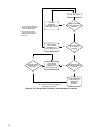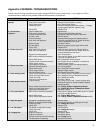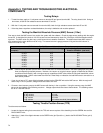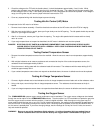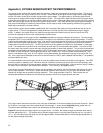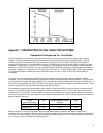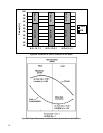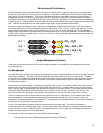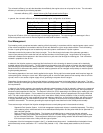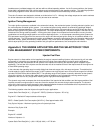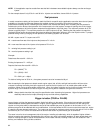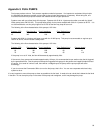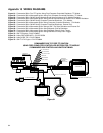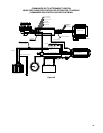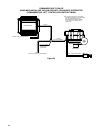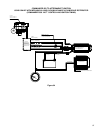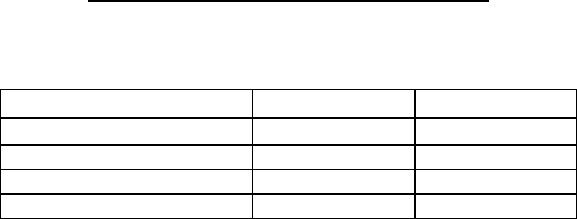
80
The volumetric efficiency is a ratio that describes how efficiently the engine acts as an air pump for its size. The volumetric
efficiency is calculated by the following equation:
Volumetric efficiency (VE) = Actual Volume of Air/Fuel induced into the Engine
Engine Displacement
In general, the volumetric efficiency of naturally aspirated engine configuration is as follows:
Engine Configuration VE (%VE)
Stock Engine 0.85 85%
Modified Engine 0.93 93%
Highly Modified Engine 0.98 98%
Supercharged 1.0+ 100%+
Engine with VE above 100% are supercharged or turbocharged applications. The supercharger or turbocharger is like a
blower that pushes much more air into the engine than what could be drawn in naturally.
Fuel Management
Fuel metering mainly comprises two tasks: metering of the fuel quantity in accordance with the required power output; control
of the mixture composition in accordance with the air fuel ratio desired for a given engine load condition. The fuel metering
function in spark ignited engines can be attained by two basic systems: carburetors or injection systems.
Carburetors meter fuel by means of the Venturi principle. The air flow through the throats of the carburetor generate a
vacuum (low pressure) which sucks the fuel from the float chamber via the metering jets. Larger flows of air through the
carburetor increases the low pressure in the Venturi that in turn pulls more fuel through the metering jets. Fuel is therefore
metered in proportion to the air flow.
In electronic fuel injection systems, pressurized fuel is delivered in to the incoming air stream by means of an electrically
actuated solenoid valve (fuel injector). The ECU determines the opening time of the injector to maintain the required air fuel
ratio according to the air flow that is being measured or calculated. The longer the injector is open, the more fuel is injected.
Because the fuel is delivered under pressure the fuel metering operation can be managed more precisely to meet the special
engine operating demands.
Fuel metering depends on how much load is applied to the engine. Driving uphill at constant speed would require a larger air
valve opening than cruising on a level road. When opening the air valve the intake pressure rises causing more air to fill the
cylinder, which in turn causes a higher supply of fuel, generating more power from the engine.
Regardless of engine speed, the air flow and fuel delivery is directly proportional to the load applied on the engine. The load
and the resulting air valve opening directly affects intake manifold pressure. In turn manifold pressure affects air flow and thus
fuel requirements.
In electronic fuel injection systems, also sometimes referred to pulsed systems, the fuel is metered in reference to a measured
air flow by means of solenoid activated metering valves (injectors). The airflow is measured by a sensor, which generates an
electronic signal proportional to the flow. The electronic control unit (ECU) responding to the airflow signal, meters fuel to the
engine by means of the injectors. Fuel is metered in a series of short pulses, which are proportional to the engine RPM and
load. The main components are: the fuel pump, which must deliver reliably, without pulsations in flow, at closely controlled
pressure; the injectors, which must contribute to accurate metering, without pre- or post-injection dribble, and deliver the fuel
in a highly atomized spray; and the electronic control unit. Sensitivity of the control unit to engine parameters and ambient
conditions are essential. The sensors generating the required signals must therefore function reliably and accurately.
There are two major multi-point fuel injection strategies that are currently being used in the automotive industry:
- Sequential Fuel Injection System. In this fuel management system each injector is controlled separately. The timing
of the metering event, referenced both to the crankshaft/camshaft position and the pulse width can be optimized for
each individual cylinder.
- Batch or Group Fuel Injection System. The injectors are divided into two or more groups that are activated
separately. Each group meters fuel once per each cycle of a 4 stroke engine. Each group or pair of group is offset
by one crankshaft revolution. This arrangement allows for an injector timing selection that eliminates metering the
fuel into an open intake valve. Holley uses this type of system.
A subsystem of the fuel management system is the O
2
or lambda closed loop control. Lambda defines the deviation from a
stoichiometrically correct combustion: 14.7:1 air/fuel ratio (lambda =1.00). Under steady state conditions, the O
2
sensor



